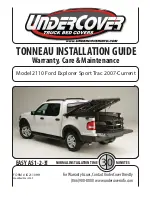
Wheels Maintenance
Tires Maintenance
CAUTION!
To obtain the best performances and
the longest mileage from the tires,
take the following precautions during
the first 310 mi (500 km):
• do not drive at the vehicle’s
maximum speed;
• drive at low speed on curves;
• avoid sudden steering;
• avoid sudden braking;
• avoid sudden acceleration;
• do not drive at high speeds for too
long.
The tires inflation pressure must
correspond to the prescribed values
(see the chapter “Tire Inflation
Pressure” in section “Features and
Specifications”) and should be
checked only when the tires have
cooled down. In fact, the pressure
increases as the tire temperature
progressively increases.
Never reduce the pressure if tires are
hot (see “Tires – General Information”
chapter in section “Driving”).
Insufficient tire inflating pressure can
cause tire overheating and possible
internal damage.
CAUTION!
After inspecting or adjusting the tire
pressure, always reinstall the valve
stem cap. This will prevent moisture
and dirt from entering the valve stem,
which could damage it.
Impacts with curbs, holes, and
obstacles in the road, and prolonged
trips on rough roads can cause tire
damage which may not be visible to
the naked eye.
Check your tires regularly for any signs
of damage (e.g. scratches, cuts, cracks,
bulges, etc.). If sharp objects penetrate
the tires, they can cause structural
damage which is only visible when the
tire is removed.
In any case, any possible damage must
be inspected by an experienced
technician, as it may seriously reduce
the tire life.
Remember that tires deteriorate with
time, even if used little or not at all.
Cracks in the tire tread and sides,
alongside possible bulging, are a sign
of deterioration.
WARNING!
•
Check the inflating pressure of the
tires when cold, at least every two
weeks and before long trips.
•
Have old tires inspected by an
experienced technician, to make
sure they can still be used safely. If
the same tire has been on your
vehicle for 4 or 5 years, have it
inspected anyway by an
experienced technician.
•
Never fit tires of uncertain origin.
•
“Directional” tires have an arrow on
their side showing the rolling
direction. To keep the best
performance when replacing a tire,
make sure that the rolling direction
corresponds to the one shown by
the arrow.
•
During the tire life, the rolling
direction used for the first fitting
should always be observed, also in
case of “nondirectional” tires.
•
Check the depth of the tire tread at
regular intervals. The thinner is the
tread, the greater is the risk of
skidding.
•
Drive carefully on wet roads to
decrease the risk of aquaplaning.
Maintenance and Care
7
349
Содержание Ghibli 2019
Страница 1: ...Owner s manual...
Страница 2: ......
Страница 4: ......
Страница 5: ...Ghibli Owner s Manual...
Страница 8: ...4...
Страница 10: ...6...
Страница 26: ...Introduction 22...
Страница 96: ...Interior Components Dashboard Components Understanding the Vehicle 3 92...
Страница 146: ...Air Conditioning Distribution Understanding the Vehicle 3 142...
Страница 235: ...Drive Mode Default Condition ESC I C E Normal ESC Normal Normal ESC Sport Sport Normal Driving 5 231...
Страница 306: ...Driving 302...
Страница 362: ...Maintenance and Care 358...
Страница 363: ...8 Features and Specifications Refillings 360 Fuel Consumption 363 Technical Data 364 Tire Inflation Pressure 370 359...
Страница 375: ...9 Index 371...
Страница 383: ......
















































